SBI Arbitrage Opportunities Fund: A smart choice for short term investments

When making short term investments, safety and liquidity are very important considerations for investors. Equity as an asset class is generally not suitable for short term investments because it is more volatile than fixed income or debt. So despite the fact that, equity is the most tax efficient asset class in India, both for short term and long term investments, investors opt for safe fixed income choices like savings bank, short term fixed deposits, money market mutual funds etc. for their short term investments. However, mutual funds offer investors another low risk and yet tax efficient option for their short term investments. Arbitrage funds are low risk mutual fund schemes, which enjoy equity taxation. In volatile equity market conditions Arbitrage Funds are good alternative investment options to liquid funds. In this post we will review an arbitrage fund from the SBI Mutual fund stable, SBI Arbitrage Opportunities Fund.
SBI Arbitrage Opportunities Fund was launched in 2006 and has around Rs 826 Crores of Assets under Management. The expense ratio of this fund is 0.9%. The chart below shows the annual returns of the fund over the last 5 years.
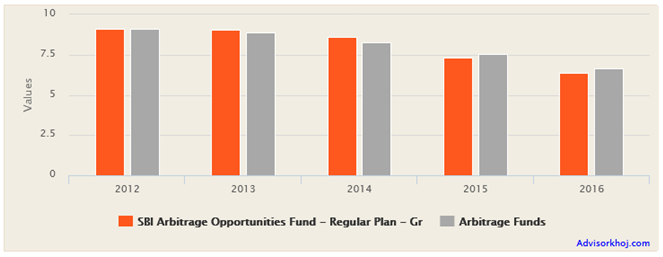
Source: Advisorkhoj Research
You can see that the annual returns of this fund over the last 5 years ranged from 6.4% to 9.1%. Variations in annual returns of arbitrage funds are much smaller than that in equity funds and even many debt fund classes. In fact, returns of arbitrage funds are closely correlated to money market mutual fund (liquid and ultra-short term debt fund) returns.
The chart below shows the NAV movement of SBI Arbitrage Opportunities Fund over the past few years. Observe that the NAV movement of this fund; it is almost linear, which implies very low volatility. Readers can also see that the NAV movement of this fund almost mirrors the shape of the CRISIL Liquid Fund Index over the same period. This reinforces our point regarding correlation of Arbitrage Fund and liquid fund returns. Arbitrage funds, like liquid and ultra-short term debt funds are among the safest mutual funds.
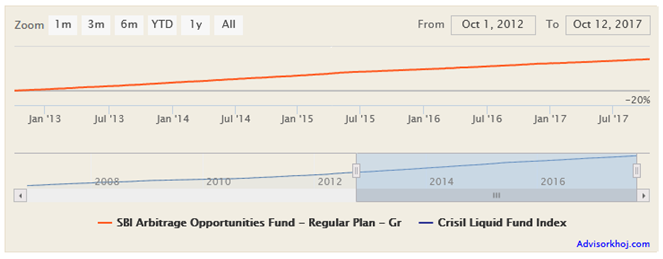
Source: Advisorkhoj Research
How do Arbitrage Funds work?
Let us first understand what Arbitrage Funds are. Arbitrage fund is a type of mutual fund that leverages arbitrage opportunities between the cash and the derivatives (F&O) markets. Many of our readers know the difference between cash and derivative markets because we have done several posts on related topics in our blog, but for the sake of all our readers we will explain the difference between the two in brief.
There are two segments in our stock markets – cash market and F&O (Futures and Options) market. In very simple terms, in cash market you have to buy stocks by paying full price of the shares. For example, if you want to buy 100 shares of a company in the cash market and if the share price is Rs 1,000 then you will have to pay Rs 100,000 to your stockbroker. On the other hand, if you want to buy 100 futures of a company (a future is equivalent to a share, but the price may differ) and the current futures price is Rs 1000, assuming your broker requires a 10% margin, you have to pay only Rs 10,000 to your broker to buy 100 futures. However, the futures contract has to be settled before the expiry of the contract (the last Thursday of the month). If the price at the time of settlement (at expiry or before if you choose) is more than your purchase price, for example if the price at the time of settlement is Rs 1,100 then your broker will pay you Rs 10,000 (Rs 100 profit X 100 futures). If the price at the time of settlement is less, for example if the price at the settlement is Rs 850 then you will have to pay your broker Rs 15,000 (Rs 150 loss X 100 futures). Please note that this is a very simplistic example because futures contracts are marked to market on a daily basis and if your marked to market margin balance falls below the margin requirement as specified by the stock exchange, you will have to pay additional margin even before settlement.
Let us now briefly discuss the price relationship between cash and futures market. There are slight differences in price of securities in cash and futures market. Futures price of a scrip can be both higher (futures trading at premium) or lower (futures trading at discount) than cash price. However, on expiry of the futures contract, the futures price and the cash price converge. The difference between futures and cash price can be exploited by investors to make risk free profits. In the ideal world, there should not be risk free profits. However, there are market inefficiencies which give rise to arbitrage opportunities, which smart investors take advantage of these opportunities to make profits with minimal or no risk.
Suppose, the price of the share of a company today in the spot or cash market is Rs 100 and the price of the November futures contract of the company in the F&O market is Rs 110. If you buy 1000 shares of the company in the cash market and sell 1000 futures, you will lock in a gross profit of Rs 10,000 today itself. On expiry of the November futures contract on 23/11/2015, the spot and futures price will converge. The expiry price is irrelevant. You will still make a net profit before other expenses. Let us understand how. Suppose the expiry price is Rs 120. You will make a profit of Rs 20 per share on the shares that you bought or took delivery in the cash market.
On the other hand, you will make a loss of Rs 10 per share in your futures. The net profit for you, before other expenses, will be Rs 10 per share or Rs 10,000 on 1,000 shares. What if, the price of the share falls to Rs 90 on expiry date? You will make a loss of Rs 10 per share you bought in cash market but you will make a profit of Rs 20 per future. Your net profit per share will again be Rs 10 or Rs 10,000 on 1,000 shares.
You can see that using this strategy you can lock in profits and there is virtually no risk, as long as you can spot the right arbitrage opportunity. However, it requires considerable expertise to identify arbitrage opportunities in the market because there are several factors (including transaction costs) to be considered in arbitrage transactions. As such, arbitrage mutual funds are best investment options for retail investors to get good returns with little or no risk.
Rolling Returns of SBI Arbitrage Opportunities Fund
The chart below shows the 1 year rolling returns of SBI Arbitrage Opportunities Fund over the last 5 years.
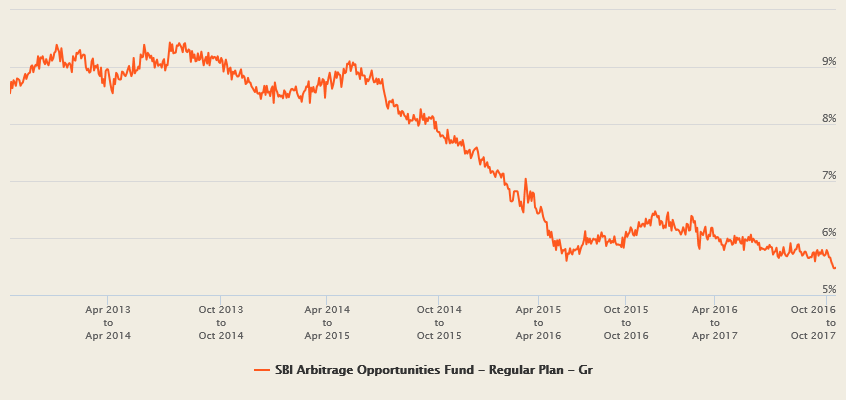
Source: Advisorkhoj Rolling Returns Calculator
You can see that the 1 year rolling returns of this fund ranged from 7% to 9% for most of the last 5 year period, but it has come down below 6% over the last 12 to 18 months or so. The average 1 year rolling returns of this fund over the last 5 year period was 7.6%. The maximum one 1 year return of this fund over the last 5 years was 9.4%, while the minimum 1 year rolling return over the same period was around 5.5%. The minimum rolling return is probably the most important indicator for investors looking to invest in arbitrage funds now; this is because arbitrage fund returns depend on prevailing market conditions.
Let us compare the rolling returns of SBI Arbitrage Opportunities Fund with a liquid fund from the SBI Mutual fund stable, SBI Premier Liquid Fund.
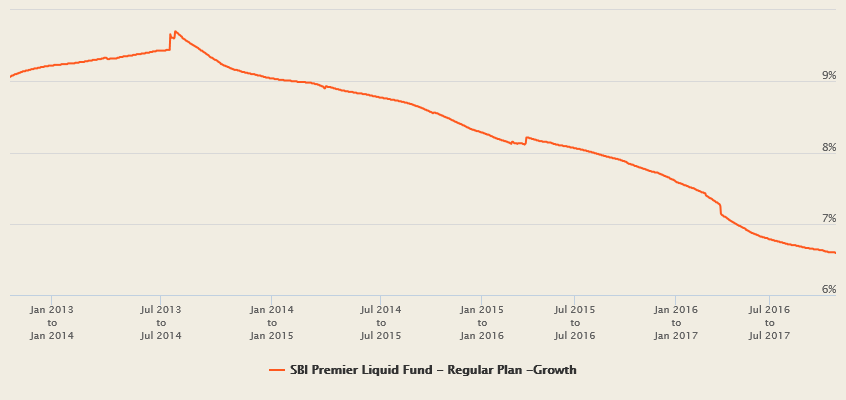
Source: Advisorkhoj Rolling Returns Calculator
Impact of tax
Investors will notice that the 1 year rolling returns in the recent past (last 1 year or so) of the liquid fund were around 1% higher than that of the arbitrage fund, but investors should always factor the impact of taxation in investment decisions. Liquid funds or any other debt fund returns are taxed as per the tax rate of the investor for investments held for less than 3 years; savings bank or fixed deposit interest are taxed as per the tax rate of investors irrespective of the tenure. If liquid fund returns are currently 6.5%, then the effective post tax return for investors is around 4.5%.
Arbitrage funds are taxed like equity funds. Short term capital gains (investments held for less than 12 months) are taxed at 15%, while long term capital gains are tax free. So if the arbitrage fund is giving 5.5% return (as opposed to 6.5% return from liquid fund) the arbitrage fund return will still be much more attractive than the liquid fund.
Furthermore, the dividends paid by liquid funds, though tax free in the hands of investors, are taxed at around 28.8%. Dividends paid by arbitrage funds, irrespective of the tenure of investment are tax free.
Dividend track record of SBI Arbitrage Opportunities Fund
The table below shows the dividend payout track record of SBI Arbitrage Opportunities Fund.
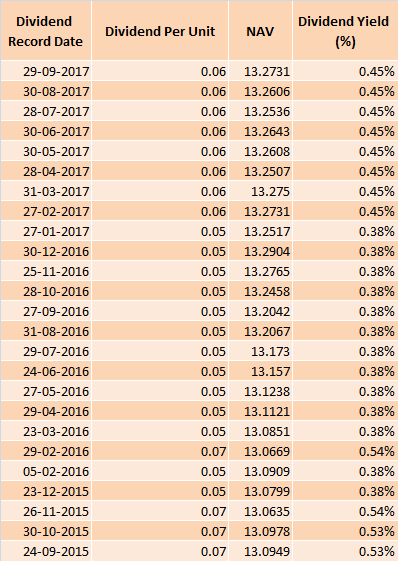
Conclusion
In this blog post, we discussed how arbitrage funds work and the tax advantages they enjoy. Getting high returns should not be the only objective in arbitrage fund investments. Risk and liquidity should be important considerations. Investors should understand that arbitrage opportunities are subject to market conditions. Considering all the factors, given the low volatility of SBI Arbitrage Opportunities Fund, it can be considered for short term investments. However, investors should discuss with their financial advisors if SBI Arbitrage Opportunities are suitable for their short term investment needs.
To know more about SBI Arbitrage Opportunities Fund, you can check here
Mutual Fund Investments are subject to market risk, read all scheme related documents carefully.
Queries
-
What is the benefit of mutual fund STP
Aug 29, 2019
-
How much to invest to meet target amount of Rs 2 Crores
Aug 26, 2019
-
Can I achieve my financial goals with my current mutual fund investments
Aug 24, 2019
-
Can you tell me return of various indices
Aug 19, 2019
-
What would be the post tax return on different investments
Aug 18, 2019
-
Which Principal Mutual Fund scheme will be suitable for my retirement corpus
Aug 16, 2019
-
What is the minimum holding period for availing NCD interest
Aug 4, 2019
Top Performing Mutual Funds
Recommended Reading
Fund News
-
DSP Mutual Fund launches DSP Nifty Next 50 ETF
Dec 19, 2025 by Advisorkhoj Team
-
DSP Mutual Fund launches DSP Nifty 500 Index Fund
Dec 19, 2025 by Advisorkhoj Team
-
Kotak Mahindra Mutual Fund launches Kotak Nifty Next 50 ETF
Dec 18, 2025 by Advisorkhoj Team
-
The Wealth Company Mutual Fund launches The Wealth Company Gold ETF
Dec 16, 2025 by Advisorkhoj Team
-
Axis Mutual Fund launches Axis Gold and Silver Passive FOF
Dec 10, 2025 by Advisorkhoj Team














